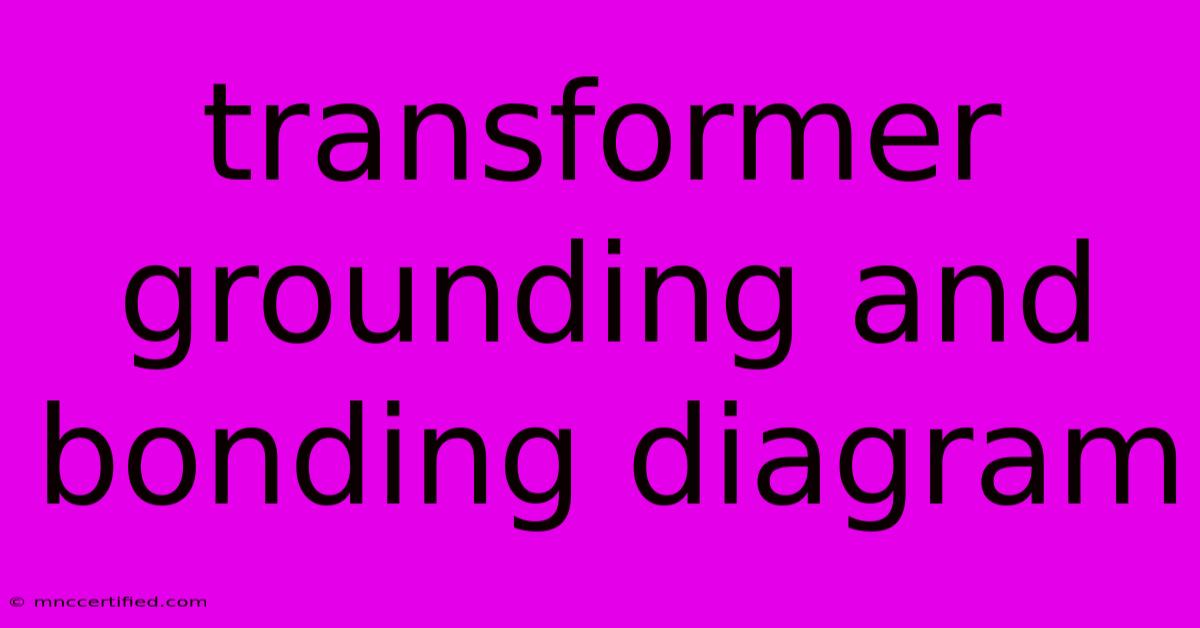Transformer Grounding And Bonding Diagram

Table of Contents
Understanding Transformer Grounding and Bonding Diagrams: A Comprehensive Guide
Transformers are essential components in electrical systems, playing a crucial role in voltage transformation and power distribution. Ensuring their safety and reliability is paramount, and this requires proper grounding and bonding. Grounding and bonding diagrams provide a visual representation of these critical connections, outlining how the transformer and its associated equipment are connected to the earth.
This article will delve into the intricacies of transformer grounding and bonding diagrams, explaining their importance, common configurations, and how to interpret these diagrams effectively.
Why Grounding and Bonding Diagrams are Essential
Grounding and bonding diagrams are essential for several reasons:
- Safety: Proper grounding and bonding helps to minimize the risk of electrical shock by providing a low-resistance path for fault currents to flow to the earth.
- Equipment Protection: Grounding helps to protect transformers and other equipment from damage caused by lightning strikes, surges, and other electrical disturbances.
- System Stability: Grounding and bonding help to maintain the stability of the electrical system by providing a reference point for voltage.
Key Elements in Transformer Grounding and Bonding Diagrams
Transformer grounding and bonding diagrams typically include the following elements:
- Transformer: The transformer itself, with its primary and secondary windings clearly marked.
- Grounding Connections: The points where the transformer is connected to the grounding system, often represented by a ground symbol (a triangle with a vertical line).
- Bonding Connections: The connections between metallic parts of the transformer and its associated equipment, ensuring electrical continuity.
- Grounding Electrodes: The physical ground electrodes, such as ground rods or plates, that provide a path for fault currents to flow to the earth.
- Grounding Conductor: The conductors used to connect the transformer and other equipment to the grounding system.
Common Transformer Grounding Configurations
There are several common grounding configurations used for transformers, each offering different levels of protection and suitability for specific applications:
- Solid Grounding: This configuration provides the highest level of protection by connecting the transformer's neutral point directly to the grounding electrode. It offers immediate fault current paths and minimizes voltage rise during faults.
- Resistance Grounding: This configuration uses a resistor in the grounding path, limiting the fault current. It's typically used in systems with high fault currents to minimize the risk of equipment damage.
- Reactance Grounding: This configuration utilizes a reactor in the grounding path, limiting the fault current. It offers a balance between fault current limitation and voltage rise control.
- Ungrounded (Floating) System: This configuration has no intentional connection to earth. It is generally not recommended for power systems due to the high risk of voltage rise during faults.
Interpreting Transformer Grounding and Bonding Diagrams
Interpreting grounding and bonding diagrams requires understanding the symbols and conventions used. Here's a quick guide:
- Ground Symbol: A triangle with a vertical line represents a ground connection.
- Bonding Symbol: A solid line connecting two points indicates a bonding connection.
- Wires: Different wire colors or markings indicate the type of conductor, such as grounding conductors.
- Labels: Labels are used to identify equipment, components, and connection points.
Example Transformer Grounding and Bonding Diagram
Imagine a simple single-phase transformer connected to a distribution network. The grounding and bonding diagram for this system might look like this:
Transformer: Single-phase transformer with primary and secondary windings. Grounding Connection: The neutral point of the transformer is connected to a ground rod via a grounding conductor. Bonding Connection: The transformer's metallic frame is bonded to the grounding conductor. Grounding Electrode: A ground rod is used as the grounding electrode. Grounding Conductor: A dedicated grounding conductor connects the transformer and the ground rod.
[Insert a simple diagram illustrating this scenario]
Best Practices for Transformer Grounding and Bonding
- Use Proper Grounding Conductors: Select conductors with sufficient size and material to handle the expected fault currents.
- Ensure Proper Connections: Securely connect all grounding and bonding components to ensure reliable connections.
- Regular Inspections: Conduct regular inspections to ensure the integrity of grounding and bonding connections.
- Professional Installation: Hire qualified electricians for the installation and maintenance of grounding and bonding systems.
Conclusion
Transformer grounding and bonding diagrams are crucial for ensuring the safety and reliability of electrical systems. Understanding these diagrams and their key elements is vital for professionals working with transformers. Implementing proper grounding and bonding practices will minimize electrical risks, protect equipment, and ensure the smooth operation of electrical systems.

Thank you for visiting our website wich cover about Transformer Grounding And Bonding Diagram. We hope the information provided has been useful to you. Feel free to contact us if you have any questions or need further assistance. See you next time and dont miss to bookmark.
Featured Posts
-
Nasdaq Gains 500 Points Johnson Controls Reports Strong Earnings
Nov 07, 2024
-
Pelvic Floor Therapy Covered By Insurance
Nov 07, 2024
-
Polymarket Election Day Success 240 Million Traded
Nov 07, 2024
-
Trump Investigation Expected To Conclude Soon
Nov 07, 2024
-
Direct Repair Programs Insurance Companies
Nov 07, 2024